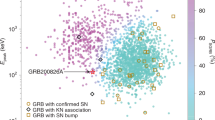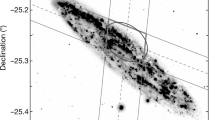Abstract
Gamma-ray bursts (GRBs) have been controversial since their discovery, mainly because of the absence of counterparts at any other wavelength that would help identify the nature of the astrophysical object associated with them; this in turn could determine their distances and luminosities, providing some constraints on their physical parameters. The absence of identifiable counterparts, as well as certain spectral features attributed to red-shifted e+–e– annihilation radiation, has led to the conclusion that they occur on isolated neutron stars and hence their luminosities should not be far in excess of ˜1038ergs–1, the Eddington luminosity for a solar mass object. On this assumption, the observed fluxes of 10–5–10–6 erg cm–2 s–1 gave distance estimates of the order of a few kpc, although their isotropic distribution may be in conflict with such an assumption. Perhaps the most controversial GRB is that of 5 March 1979, precisely because there is an accurate positional identification of this burst1 with a known astronomical object, the supernova remnant N49 in the Large Magellanic Cloud (LMC). Such an association would fix the distance at 55 kpc, and with the observed flux (this is by far the brightest GRB observed to date), would require prodigious energy and luminosity from this GRB (l044erg and l044ergs–1 respectively), casting doubt, on theoretical grounds, on its distance and its physical association with the LMC. However, some Kosmos 856 observations2 may provide more direct evidence on energy released and hence give a decisive answer to this question.
This is a preview of subscription content, access via your institution
Access options
Subscribe to this journal
Receive 51 print issues and online access
$199.00 per year
only $3.90 per issue
Buy this article
- Purchase on Springer Link
- Instant access to full article PDF
Prices may be subject to local taxes which are calculated during checkout
Similar content being viewed by others
References
Cline, T. L. et al. Astrophys. J. 255, L45–L47 (1982).
Loznikov, V. M. et al. Sov. Astr. Lett. 6, 321–322 (1980).
Mazets, E. P. et al. Nature 282, 587–589 (1979).
Helfand, D. & Lond, K. S. Nature 282, 589–591 (1979).
Aharonian, F. A. & Ozernoy, L. M. Astronomicheskii tsirkular No. 1072, 1–4 (1979).
Schmidt, W. Nature 271, 525–526 (1978).
Felten, J. E. Proc. 17th int. Cosmic. Ray Conf. 9, 52–55 (1981).
Ramaty, R. et al. Nature 287, 122–124 (1980).
Ellison, D. C. & Kazanas, D. Astr. Astrophys. 128, 102–109 (1983).
Ramaty, R., Lingenfelter, R. E. & Bussard, R. W. Astrophys. Space Sci. 75, 193–198 (1981).
Detweiler, S. L. Astrophys. J. 197, 203–217 (1975).
Terrell, J. et al. Nature 285, 383–385 (1980).
Haensel, P. & Proszynski, M. Astrophys. J. 258, 306–320 (1982).
Liang, E. P. Astrophys. J. 308, L17–L20 (1986).
Cline, T. C. Adv. Space Res. 6, 5–14 (1986).
Kazanas, D. & Ellison, D. C. Adv. Space Res. 6, 81–84 (1986).
Guilbert, P. W., Fabian, A. C. & Rees, M. J. Mon. Not. R. astr. Soc. 205, 593–603 (1983).
Kazanas, D. Astr. Astrophys. 166, L19–L22 (1986).
Author information
Authors and Affiliations
Rights and permissions
About this article
Cite this article
Kazanas, D. The origin and location of the 5 March 1979 gamma-ray burst. Nature 331, 320–321 (1988). https://doi.org/10.1038/331320a0
Received:
Accepted:
Issue Date:
DOI: https://doi.org/10.1038/331320a0
Comments
By submitting a comment you agree to abide by our Terms and Community Guidelines. If you find something abusive or that does not comply with our terms or guidelines please flag it as inappropriate.



